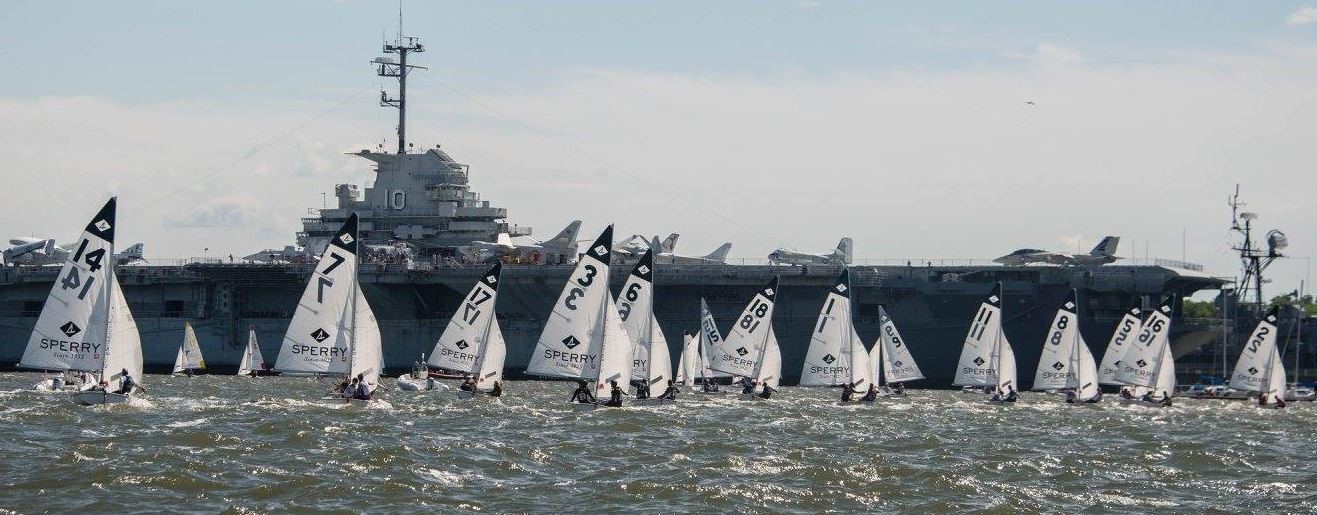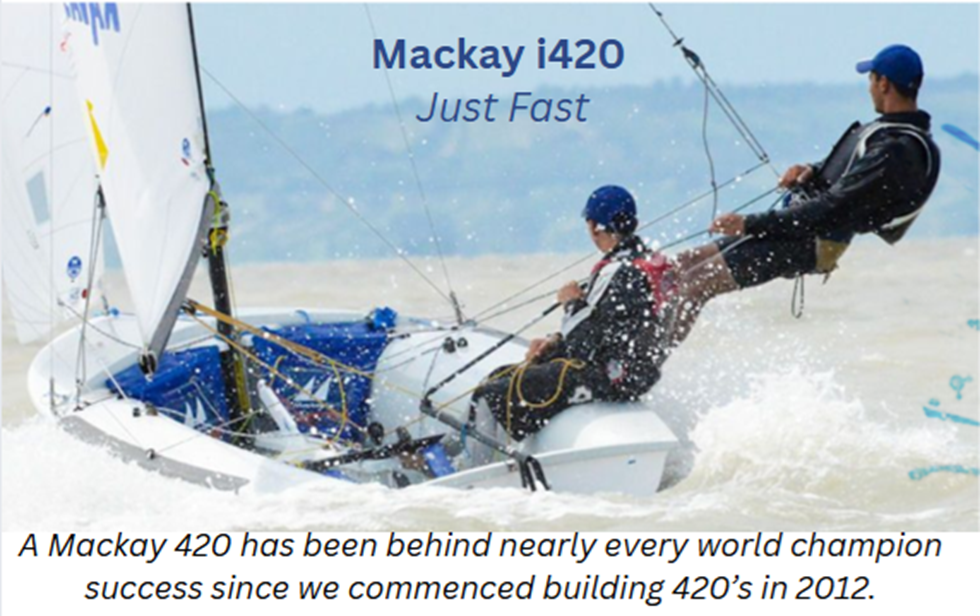#1 Yale University won the Fowle Trophy, New England’s Team Race Championship, hosted by Connecticut College. The Bulldogs have been slow to start regattas this spring season. At the Fowle, however, they flipped the script on that narrative and, in doing so, proved that they are the best in NEISA in a variety of sailing conditions. Posting a 10-1 record in the round of 12 and a 5-2 record in the round of 8, Yale was the outright winner in a extremely deep field.
Yale sailed Nic Baird ‘19 with Graceann Nicolosi ‘20, Shawn Harvey ‘21 with KB Knapp ‘18 and Malcolm Lamphere ‘18 with Sonia Lingos-Utley ‘21.
While being crowned the champs of NEISA is noteworthy, it is undoubtedly not the end goal for Yale. This regatta, while a conference championship, is also a qualifying regatta offering 4 tickets to the big dance and a chance at the ICSA Team Race National Championship. The fight for 4th is where this event really got interesting.
At 5:30 in the evening, an hour past the deadline for racing, 3 teams were still sailing a three way sail off for the fourth and final qualifying spot. #3 Boston College, #8 Harvard and #18 Connecticut College sailed a three way, tie breaking round to determine whose season would continue and whose would end. The winner of two races would advance to the national championship. If the three teams all finish 1-1, the sailoff would continue into the evening.
Boston College started against Connecticut College and defeated them with a dicey 1-3 finish where Boston College had to execute a perfect tack on the finish line to win the race. The winning team continued to face Harvard with an opportunity to win both sail off races and advance. Boston college started behind Harvard and were facing a possible play 2 moving up the first beat. Harvard failed to balance completely and BC was able to catch one boat and convert to a winning play of their own. They kept the winning play, the 1-4-5, for most of the downwind before flipping it to a play 2, 2-3-4. They maintained the play two over the last two legs of racing and, despite Harvard’s best efforts, finished 2-0 in the sail off round and will advance to nationals.
#4 Roger Williams finished second with a 13-5 record. An underrated #13 Dartmouth finished 3rd with a 11-7 record.
#5 Georgetown won the Capt. Prosser Trophy, the Mid Atlantic’s Team Race Championship. Similar to the Fowle, NEISA’s championship and qualifier, the top four teams at the Prosser advance to the national championship.
Throughout the event, the Hoyas distanced themselves from the field sailing two round robins with a 6-1 record and one round sailed undefeated. This Georgetown team is not young anymore and they have the speed and boat handling to beat anyone in any condition.

Again, like the Fowle, the drama of the Prosser occured around the 4th and final qualifying position. However, unlike the Fowle, the conditions were full on with whiteout snow, wind and waves. “It was intense,” said Cornell Head Coach, Brian Clancy. “Racing was never in doubt. It was a cold 10-15 knots out of the North and steady. There was a feeling in the air throughout the event and you could cut that tension with a knife on Sunday.”
“It was by far the coldest regatta in memory,” said Hobart and William Smith head coach. “We put windshield de-icer on the sheets and controls to keep the lines functional. It was miserable with wind chill below 20 degrees and big snow squalls would rolling through causing the race to disappear as we watched from land.”
Notably, the home team, Cornell, beat out #15 St. Mary’s, #10 Navy and #17 Old Dominion University to grab their first trip to Team Race Nationals in their team’s history. Cornell sailing has been around since the 1930’s and Team Race nationals has been a part of the ICSA championship schedule since the 70’s.
“We lost our first 3 races of the day on Sunday,” said Mr. Clancy. “And we knew St. Mary’s was coming, we had to win our next race against them. St, Mary’s beat us badly off the line and we had one boat able to hold on and mix it up and get us back into the race at mark one. It was on after that.”
Cornell had to beat #11 George Washington in their last race of the regatta to win the tiebreaker against St. Mary’s and though the two teams finished with the same record, Cornell went 3-0 against St. Mary’s throughout the event and therefore no sailoff was necessary.
“It is a big deal,” continued Clancy. “It is the first time in our programs history that we’re moving on to the Team Race National Championship and it’s a special group. They put in the time, we pushed them and they responded in a big way. It means a ton to the program, the current sailors, the alums and the larger Big Red Community.”
George Washington finished second at 15-6 including a 2-1 record against #2 Hobart and William Smith Colleges, who finished 3rd. George Washington also made history, like Cornell, qualifying for their first team race national championship.

#6 College of Charleston won the SAISA Team Race Championship with a 7-0 record. The defending national champions had been sliding in the weeks prior to their conference championship, but they proved last weekend that they are still the premier team in the South Atlantic.
The Cougars sailed Christophe Killian ‘18 with Elizabeth Pemberton ‘18, Augie Dale ‘19 with Katherine Lounsbury ‘20 and Stefano Peschiera ‘18 and Grace McCarthy ‘18. If this team continues to improve they could challenge for another team race championship as Charleston knows how to peak at the right moment.
A theme at these conference championships, the excitement was found around the last qualifying spot. Unlike MAISA and NEISA, SAISA only gets 2 qualifying spots. That spot was decided by a one-race sailoff tiebreaker between University of South Florida and Eckerd College. The team race season of these two teams came down to one race where USF was able to sail away and claim their spot at Nationals with a decisive 1-2-3 finish.
In SAISA the team race championship/ qualifier is decided on the same weekend as the fleet race championship, SAISA Coed Champs.
College of Charleston walked away with their second championship of the weekend with a 26 point victory over Eckerd. While SAISA only receives 2 spots to nationals in team racing, the top 5 teams at the fleet race championship get berths to the ICSA Semi-final regatta.
Charleston’s victory can be attributed to College Sailor of Year font-runner, Stefano Peschiera ‘18 with Grace McCarthy ‘18 and Elizabeth Pemberton ‘18 in an A-Division victory and Augie Dale ‘19 with Carter Cameron ‘19 and Katherine Lounsbury ‘20 winning B-Division.
Eckerd finished second with 72 points, USF, 3rd with 91 points, Jacksonville 4th with 137 points and Florida State 5th at 146, one point ahead of University of Miami for the last qualifying spot.
Texas A&M University at Galveston also booked their ticket to the Team Race National Championship with an undefeated, 6-0 performance at the SEISA Team Race Championship. The format was a double round robin with four teams present at the regatta.
John Hanna ‘19, John Jacobs ‘19, Jonathan Sager ‘20, Ava Cares ‘20, Alex Schwinn ‘19 and Lyndsey Sager ‘21 got the job done for the Aggies, capturing the one and only berth for the Team Race National Championship.
Like the SAISA qualification process, both the SEISA qualifiers for Fleet Race and Team race nationals are determined on the same weekend.
Texas A&M won the SEISA Dinghy Championship as well, winning all but two of the 14 races in the event.
John Hanna ‘19 skippered with Jonathan Sager ‘20 assuming the crew role in the A-Division winning effort for 6 of the 7 races. However, the tandem switched spots, the crew, Sager, now skippering and the former skipper, Hanna, in the front. Showing the versatility of the A-Division boat, Hanna and Sager still won the race.
Alex Schwinn ‘19 with Lyndsey Sager ‘21 and Ava Cares ‘20 won B-Division for the Aggies with 9 points in 7 races.
Tulane was second with 26 points, finishing second in all but two races. Texas was third with 51 points beating out Texas A&M (not Galveston) for the final spot to the ICSA Semi-Final Regatta.
Blog
Conference Championships: #1 Yale, #5 Georgetown, #6 Charleston and Texas A&M Galveston victorious and Nationals bound
Summer Sports Camp Seeking Sailing Director
Mobile Brand Ambassador
Nautivela I420 For Sale. Hull #55998. Get Ready For 2018 Worlds! Stored Indoors. Used 1.5 seasons.
Sailing Won’t Get You Into College
By Airwaves Writer Chris Klevan
Editors Note: We invite your comments and thoughts. Please see below or click the “Leave a Comment” button.
One afternoon in early June, 2013, the Head Coach of the Boston College Varsity Sailing Team, Greg Wilkinson, sent an email to Zack Leonard, Head Coach of the Yale sailing team. The email contained an attachment, an open letter titled, “Dear Youth Sailing Parents.” The first line of the letter reads, “We’re writing to apologize for misleading you.”
Mr. Wilkinson hoped that all the college sailing coaches would sign the letter, aspiring that the leaders from college sailing, collectively, could save the readers from themselves. Unfortunately, this letter was never sent.
The letter echoes the sentiments felt by many coaches across college sailing. It was written to try to flip the misconception about youth sailing’s impact on any given sailor’s future in college. True, junior sailing can help one hone some of the skills needed to get ahead of the steep learning curve that is college sailing. There’s no doubt that most of the best in the game today have had success in sailing prior to arriving to college. However, skipping your SAT prep class to crisscross the country building the “perfect” sailing resume is a terrible misstep. Moreover, to suggest that there is any one class of boats that is more relevant due to the attention coaches pay to it is totally off base.
“We are NOT looking for class champions from any one particular class,” stated Wilkinson. “You would be ill advised to counsel your sons and daughters to sail a particular boat because ‘that’s the boat that the college coaches pay attention to’. That single boat does not exist.”
Wilkinson continued in 2013, “I estimate that 15-25 kids per year get accepted into colleges where, without support from the coach, they would have been rejected.” In other words, only 15 to 25 of the thousand-plus applicants have a sailing resume that is strong enough to get them into a better school than their grades would otherwise justify. That’s only about 2%. For everyone else, the academic profile of the sailor will always match the academic profile of the school to which they are applying.
Very few college sailing teams cut players. If you have a background in racing and an eagerness to learn, there is a spot on a team somewhere. But you still have to get in, and your grades are your most important asset. You should be visiting schools early in your Junior year of high school, for it is your job, as the applicant, to find the right school and the right team for you.
“Kids should keep their focus on academics while enjoying their sailing,” said Zack Leonard of Yale University.
“There’s a range all schools are looking for,” said a head sailing coach who wished to speak only off the record. “If you fit into that range you have a chance to get in.” Sailing can create a positive relationship with a coach, who probably has some relationship with an admissions department. If the coach feels that you may fit into the team culture he or she is trying to maintain, that coach may be able to shine a light—but only if you already fit into the academic range. If a coach does not seem interested in you, that likely indicates the coach does not feel you are experienced enough as a sailor to add value to their team or you do not have a strong enough academic profile to be accepted. Do not be discouraged, there is a home for you if you want to sail in college.
John Vandemoer, head coach of Stanford University, said, “We rarely support a player that only does high school sailing, we really look for players that love the sport, love being on the water and are eager to learn multiple disciplines.”
John Pearce, former Head Coach at the George Washington University and currently Youth Director at US Sailing, adds “Several of the best recruits we had at GW were kids who were trapeze crews in the C420 and the 29er and also did high school and laser sailing on the side. It was immediately apparent that trapeze crewing had developed their feel for the boat and awareness of balance and apparent wind in a way that “sit down” sailing doesn’t. It was easy to get them up to speed in the collegiate dinghies, and they just kept getting better and better. Some of the kids who only sail one boat as youth sailors are missing out on the opportunity to expand their abilities and develop a more well-rounded skill set.”
The college game, however, is very different than that of junior sailing. What you must understand, as a trapeze crew, is that you will be skippering in practices and advancing through the various levels of regattas in college sailing as a skipper. This will broaden your ability as a career sailor and improve your tactical awareness. The collegiate FJ is extremely underpowered compared to junior sailing boats featuring trapezes. It is only at the championship level regattas that the professional heavy air crew is of value to college coaches.
There are very few schools that support the majority of their sailors in the admissions process. There are no schools that can get you a break on your tuition due to sailing. The ICSA rules explicitly prohibit scholarships based on sailing ability. Again, it is the grades get you in and help you with tuition. It is not the coaches or the sailing that will get you into the school of your dreams.
What you, the sailor, should seek in your interactions with different coaches across college sailing isn’t help getting into school, but rather a better understanding of the subtle differences between schools and sailing teams. Once you find the school that seems right for you, the next step is to work hard to improve all your scores. Your best move is to study. Try to make yourself as desirable as possible, not in the eyes of Greg Wilkinson or John Vandemoer, but in the eyes of whichever admissions officer might read your application. Then, once you get in, go to the best school possible in terms of academics, find a school with programs that fit your interests, and join the sailing team with an open mind.
College sailing offers a unique sailing experience where teamwork is extremely important. It offers an opportunity for average sailors to become good sailors, and in the meantime they can help their friends become great. It is an umbrella that collects a ton of sailors from different backgrounds and puts them all on an even playing field. The equipment is extremely simple and basic. The courses are small and often light and shifty. It helps show an individual that, with hard work and some skill, you have a shot to be the best. It helps show a group of people that, together, they can decide on a goal, work hard, support each other and, win or lose, the experiences and the bonds built are invaluable. But it is just a small, fun, well-connected niche in the sailing world. It does not lead to a career in sailing. The vast majority of college sailors use their experiences and the degree they earned to get a job outside of sailing and perhaps they have their team picture hanging above their desk, next to their diploma.
Sailing in college is an excellent way to spend your four years. However, it is not what you are applying for. It, in itself, will not get you into college and, therefore, neither will your time spent on the youth sailing circuit or your visit with the varsity sailing coach. The letter Mr. Wilkinson wrote and never sent was supposed to cut at that misunderstanding. Every college sailing coach wants highly skilled sailors who can be good leaders and are always great people. We want people to add to our teams in as many aspects as possible. However, we do not want to waste your time.
Sailing before college can help shape your college application. Sailing is a great extracurricular activity, like chess or the debate team. It can help show that the applicant is passionate about her or his interests. That, coupled with good scores, can help separate the sailor from all the other qualified applicants in a stack of paper sitting in an admissions department. For 98% of kids applying to schools with an attached sailing resume, that is the extent of youth sailing’s function on a college application.
For a quick look at the student’s point of view, see our article, “College Sailing From the Recruits Point of View”
Photo take from ICSA on Facebook





